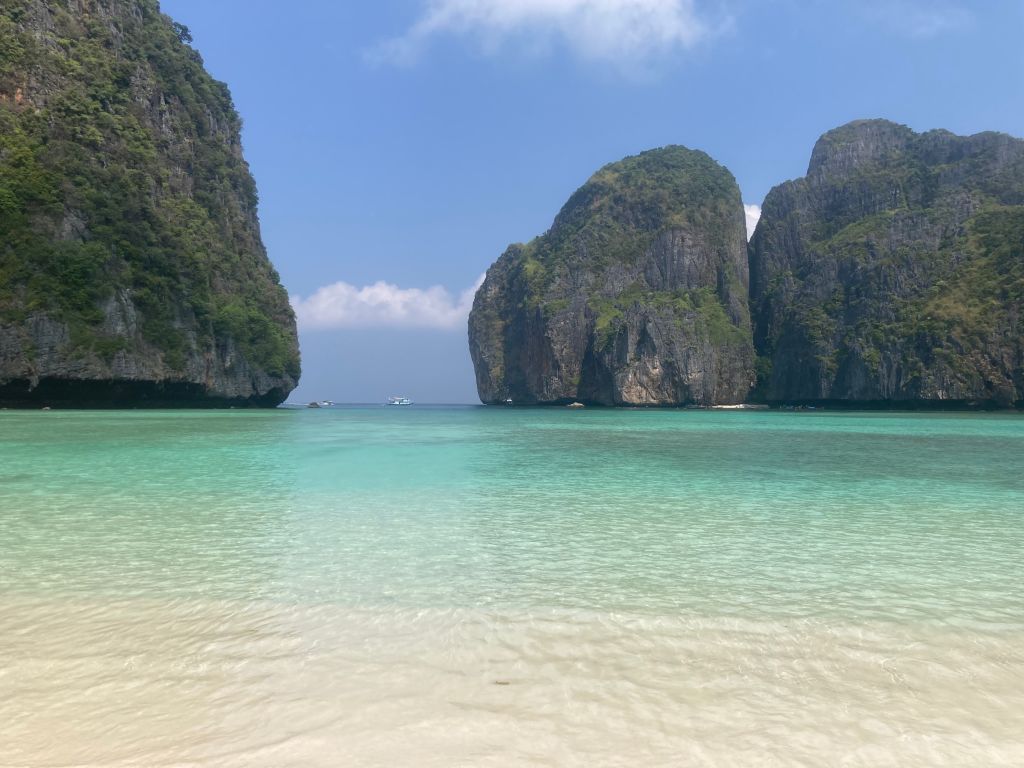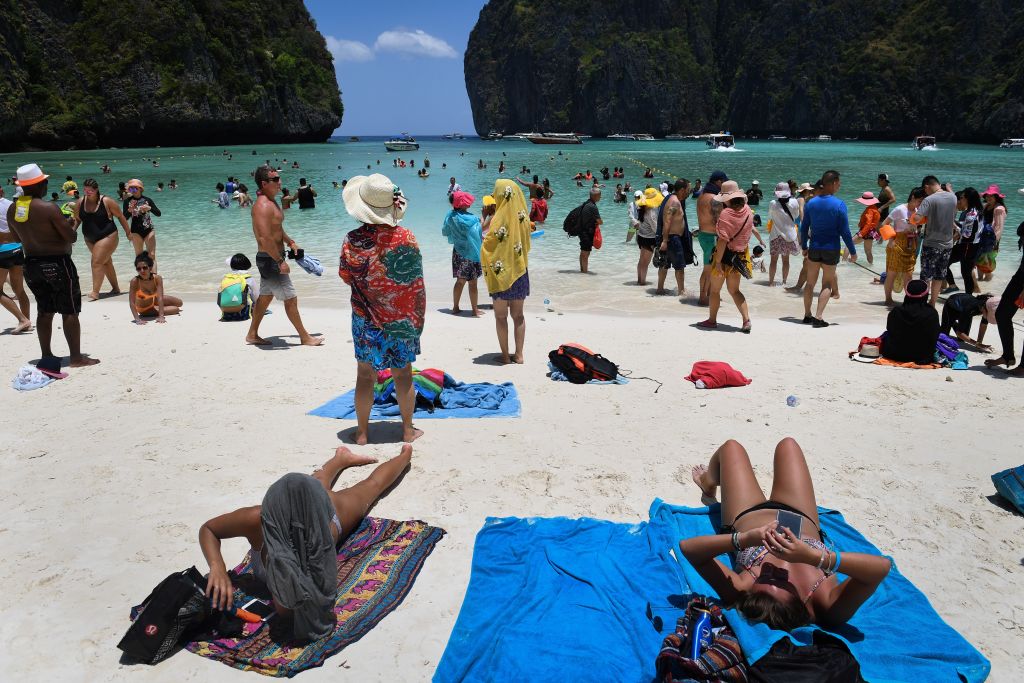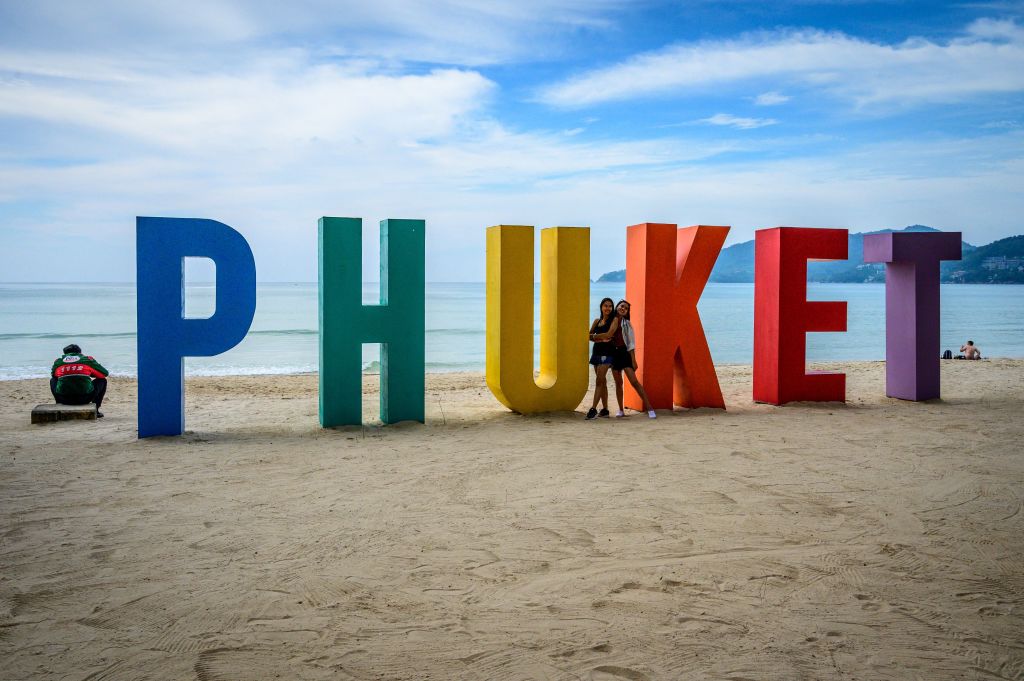
Standing on the crowded corso of Ton Sai Bay last Saturday, it was difficult to see that Thai tourism was in the doldrums. Hordes of visitors—sandals and smartphones held aloft—were making amphibious landings from an armada of tourist boats and marching up the beach.
Ton Sai is where daytrippers to Phi Phi Don, the larger isle in the Phi Phi islands group, stop for lunch at a pair of cacophonous, hangar-like restaurants, designed for large numbers of people to feed efficiently on cheap buffets. Afterward, they pack the beach for the obligatory selfies, searching for a few square feet of uncrowded sand to preserve the Instagram myth of Phi Phi as the sundrenched haven of gorgeous influencers in straw fedoras and diaphanous beachwear—not a place overrun with humanity.
Read More: Is the Summer of Revenge Travel Here?
And yet to a boyish Thai guide standing nearby, sporting floppy bangs and a chunky earring, the sight is a troubling one. He exhales through gritted teeth and says the crowd is “not even half” what it was before the pandemic began in early 2020.
“The Chinese aren’t here,” agrees a visitor, a softly spoken Shanghainese expatriate who has been living in the U.K., scanning the mostly Middle Eastern, South Asian, and European faces. Beijing’s draconian COVID restrictions have dried up Thailand’s biggest tourism market. Its revival is anxiously awaited at all levels of the kingdom’s tourism industry, but will world renowned islands like Phi Phi be able to cope with business as usual?
The fate of Phi Phi’s most renowned attraction, Maya Bay, stands as a warning.

The dangers of overtourism
Maya Bay, on Phi Phi Leh, is famous as a location in Danny Boyle’s 2000 flick The Beach, starring Leonardo DiCaprio. Part of the Hat Noppharat Thara-Mu Ko Phi Phi National Park, the stunning cove is surrounded by dramatic cliffs and boasts an exquisite, 250-meter white crescent strand that is the platonic ideal of a beach.
In the wake of the movie, the trickle of visitors to Maya Bay became a deluge. As many as 4,000 arrived daily on flotillas of tourist boats that damaged the coral and scared off the blacktip reef sharks that used the bay as a mating pool. Crowds trampled the delicate sea floor. To stop further damage, authorities closed Maya Bay to tourists in June 2018.
When it reopened in January this year, visitors were limited to 380—not per day, but per hour. Approaches by boat were banned, as was swimming. Tourists had to disembark at a pontoon pier at nearby Loh Sama Bay, then walk to Maya. It hasn’t been enough. Environment minister Varawut Silpa-archa said that even with the new measures, Maya Bay was “inundated” over Songkran—the country’s New Year holiday held in April.
At the start of August, the famous cove was closed again for two months, coinciding with the low season. It’s the local equivalent of roping off Paris’ Eiffel tower or Rome’s Coliseum.
Wave conditions permitting, tourist boats now bob at the entrance of the bay for a few minutes, so disappointed passengers can take photos from a distance, and then proceed to the Pileh Lagoon. The latter is another social media hotspot, where it is easy to see why tourism is both a blessing and curse to these small islands. At Pileh, party boats blaring loud music moor beneath spectacular limestone escarpments, while giddy daytrippers fling themselves into water that has seen better days. Plastic bottles and cigarette butts wash up against the rocks.
Read More: Can Barcelona Fix Its Love-Hate Relationship With Tourists?
Thon Thamrongnawasawat, a marine scientist at Kasetsart University in Bangkok and an expert on Maya Bay, tells TIME that 70-80% of the cove’s coral reefs were intact 30 years ago. When the bay was closed in 2018, only 8% of the reefs were alive. During the three-year closure, Thon and others replanted tens of thousands of new pieces of coral and about 50% of those have survived.
But it may be difficult, if not impossible, to undo decades of damage. “As a marine scientist, if you would try to close the bay permanently, it’s my happiness,” says Thon. But he concedes that in Thailand, where tourism accounts for around a fifth of GDP, the preservation of marine ecosystems can mean misery for local people.
The two popular jumping off points for the islands are Phuket and Krabi, being just an hour and 45 minutes respectively from Phi Phi by speedboat. The importance of foreign holidaymakers to both places cannot be overstated.
On the streets of Phuket, tourism is seemingly all there is: every shopfront seems to offer boating trips, taxi services, car and scooter hire, visa runs, strong cocktails, snorkels, massages, boba tea, plates of Pad Thai, or laundry. Sometimes they offer all of the above, in signs written in English, Russian, and Chinese.
Because of the pandemic, “we haven’t had income for two years,” says one operator, who books tours, runs a mini laundrette, and chauffeurs tourists in his family Toyota. “Luckily, we were able to rent out our house, otherwise we would have had no income at all.”

Thailand and sustainable travel
Andrew Hewett, who manages the Phi Phi Island Coral Nursery, sees no major benefit to Maya Bay’s current two-month closure. He says a high-season shutdown would be more effective: “Closing it during a period when there’s a lot of people—then you’re reducing the impact considerably.” Tour operators must also be educated about the bay’s sustainable capacity, Hewett adds.
That will not be an easy task. Tours of Phi Phi are marketed as sybaritic photo opportunities instead of mindful expeditions to ecologically threatened places. They’re affordable, too. A full-day, guided tour to Phi Phi from Phuket—taking in local spots like Monkey Beach, the “Viking” Cave, and Pileh Lagoon—can be had for less than $60 a head, with snorkeling, kayaking, lunch, soft drinks, and snacks thrown in.
Each tour provides income for many people besides the travel agents, operators and guides. There are the minivan drivers who pick you up from your hotel and take you to the pier; the boat crews; the people who rent out snorkels, flippers, towels, and deck chairs; the restaurants and all their staff; the old ladies selling coconut ice-cream and sticky rice at Ton Sai Bay; the hawkers offering bags of chilled pineapple; the local store with its stocks of sunhats and sunblock; the boatmen who take you around the lagoons on their wooden skiffs; and the freelance photographers who follow you around the islands, snapping your every move, emailing you dozens of thumbnails for you to look over at the end of the day. Persuading this army of people of the value of moratoriums and quotas will always be an uphill battle.
Read More: Climate Change Is a Painful Reckoning for the Tourism Industry
Says Edward Koh, a visiting professor of tourism at Bangkok University who researched the effect on Phi Phi islanders of the years-long closure of Maya Bay: “I think we have to open at some point in time—and we will never get it exactly right.”
Anuar Abdullah, founder of Ocean Quest Global, an organization that helped repopulate Maya Bay’s reefs, echoes official thinking when he says that the cove must eventually be sold as a premium and not mass market destination, with high prices acting as a deterrent.
“The extra price they pay [will] actually help protect this heritage,” he tells TIME. “If we think about heritage, we think about a hundred or two hundred years from now—the future generations. If we don’t put these savings back, humanity has nowhere to go.”
For people dependent on Phi Phi for their modest livings, however, thinking beyond today is challenging enough. “Are you happy?” yells the young tour guide from Ton Sai, over the roar of his speedboat as it takes travelers to their next stop. “Yes” they reply, with a faint note of uncertainty.
“In Thailand,” he hoots back, “everybody happy!”
—With reporting by Aidyn Fitzpatrick/Phuket and Phi Phi
More Must-Reads from TIME
- Cybersecurity Experts Are Sounding the Alarm on DOGE
- Meet the 2025 Women of the Year
- The Harsh Truth About Disability Inclusion
- Why Do More Young Adults Have Cancer?
- Colman Domingo Leads With Radical Love
- How to Get Better at Doing Things Alone
- Michelle Zauner Stares Down the Darkness
Contact us at letters@time.com